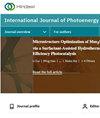Research on Multiobjective Optimal Operation Strategy for Wind-Photovoltaic-Hydro Complementary Power System
IF 2.1
4区 工程技术
Q3 CHEMISTRY, PHYSICAL
引用次数: 3
Abstract
To address the problems of wind and solar generation volatility and lose of wind and photovoltaic resources, on the basis of the complementary property of wind-solar-water, the topology structure of the wind-solar-water synergy power generation system is constructed. Taking the minimum grid fluctuation index, the minimum wind-photovoltaic-hydro discard rate and the greatest economic effectiveness of the power station as the goal functions and considering various constraints of the wind, photovoltaic, and hydrostation units, a triobjective optimization running model of the wind-photovoltaic-water synergy system is established. Meanwhile, this essay suggests an IMOSSA on the basis of tent chaotic sequence and random wandering strategy to settle the described triobjective optimization issue. Taking Hubei Pankou as an example for simulation analysis, after choosing the best scheme, IMOSSA compared with MOSSA, MOGWO, and NSGA-II, the volatility of sunny days is reduced by 12.39%, 19.5%, and 36.71%, respectively; the wind-photovoltaic abandonment rate is reduced by 11.17%, 22.5%, and 38.03%, respectively, while in the rainy days the volatility is reduced by 8.09%, 18.34%, and 47.03%, respectively; the wind-photovoltaic abandonment rate is reduced by 14.84%, 16.86%, and 40%, respectively. Therefore, it is possible to demonstrate the validity of the proposed three-objective model and the efficiency of the IMOSSA in solving the issue. The efficiency of the optimization operation approach suggested in this research is confirmed by the case study, providing a new idea for the large-scale consumption of new energy in high-proportion hydropower grids.风电-光伏-水电互补系统多目标优化运行策略研究
为解决风能和太阳能发电波动大和风能和光伏资源流失的问题,基于风能-太阳能-水的互补特性,构建了风能-太阳能-水协同发电系统的拓扑结构。以电网波动指数最小、风电-光伏-水电弃电率最小和电站经济效益最大为目标函数,考虑风电、光伏和电站机组的各种约束,建立了风电-光伏-水电协同系统的三目标优化运行模型。同时,本文提出了一种基于tent混沌序列和随机漫游策略的imosa来解决上述三目标优化问题。以湖北盘口为例进行模拟分析,选择最佳方案后,IMOSSA与MOSSA、MOGWO和NSGA-II相比,晴天波动率分别降低了12.39%、19.5%和36.71%;弃风率分别降低11.17%、22.5%和38.03%,阴雨天波动性分别降低8.09%、18.34%和47.03%;风电弃风率分别下降14.84%、16.86%和40%。因此,可以证明所提出的三目标模型的有效性以及imosa在解决问题方面的效率。通过实例分析,验证了本研究提出的优化运行方法的有效性,为高比例水电电网大规模消纳新能源提供了新的思路。
本文章由计算机程序翻译,如有差异,请以英文原文为准。
求助全文
约1分钟内获得全文
求助全文
来源期刊
CiteScore
6.00
自引率
3.10%
发文量
128
审稿时长
3.6 months
期刊介绍:
International Journal of Photoenergy is a peer-reviewed, open access journal that publishes original research articles as well as review articles in all areas of photoenergy. The journal consolidates research activities in photochemistry and solar energy utilization into a single and unique forum for discussing and sharing knowledge.
The journal covers the following topics and applications:
- Photocatalysis
- Photostability and Toxicity of Drugs and UV-Photoprotection
- Solar Energy
- Artificial Light Harvesting Systems
- Photomedicine
- Photo Nanosystems
- Nano Tools for Solar Energy and Photochemistry
- Solar Chemistry
- Photochromism
- Organic Light-Emitting Diodes
- PV Systems
- Nano Structured Solar Cells

 求助内容:
求助内容: 应助结果提醒方式:
应助结果提醒方式:


